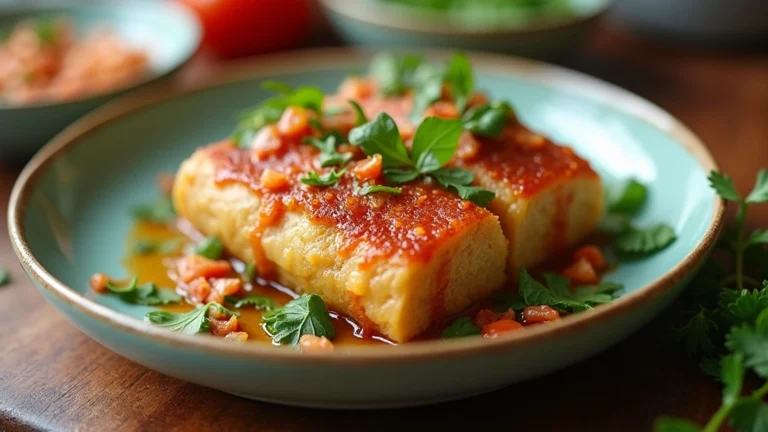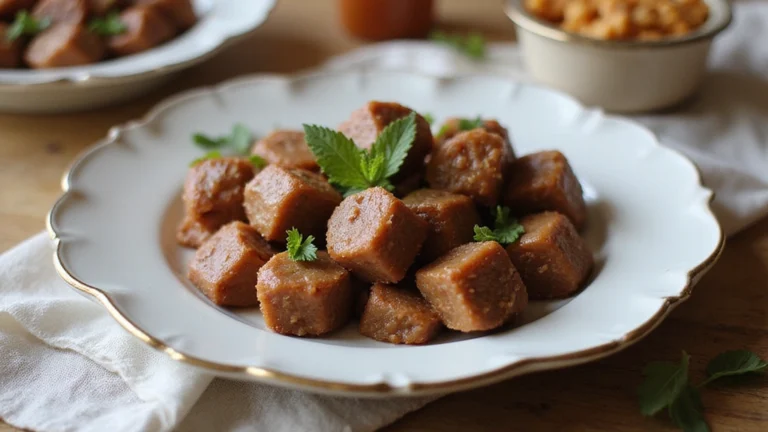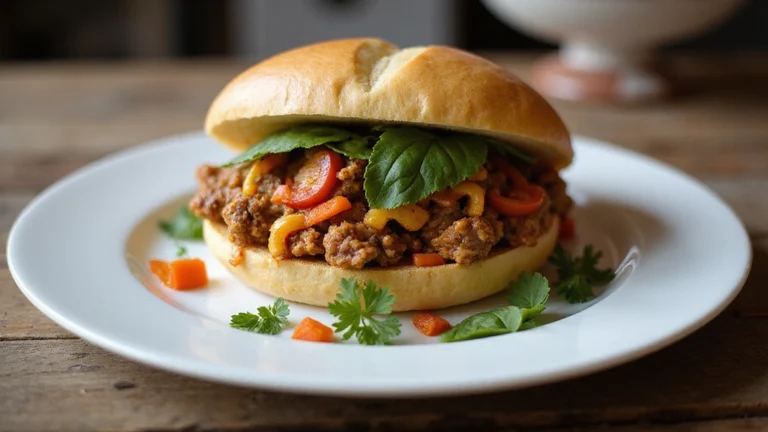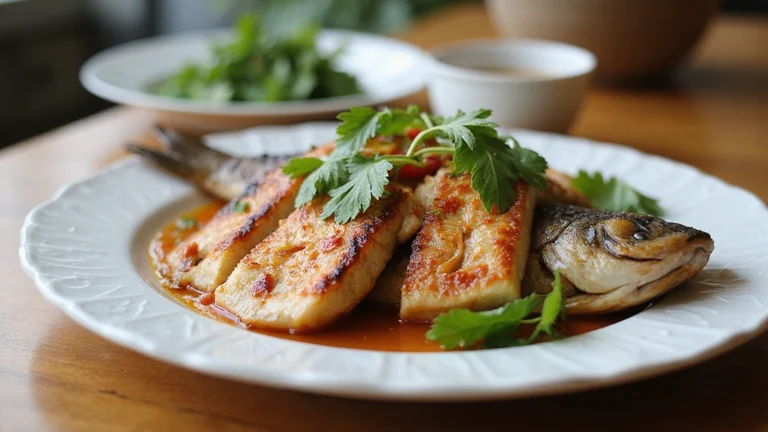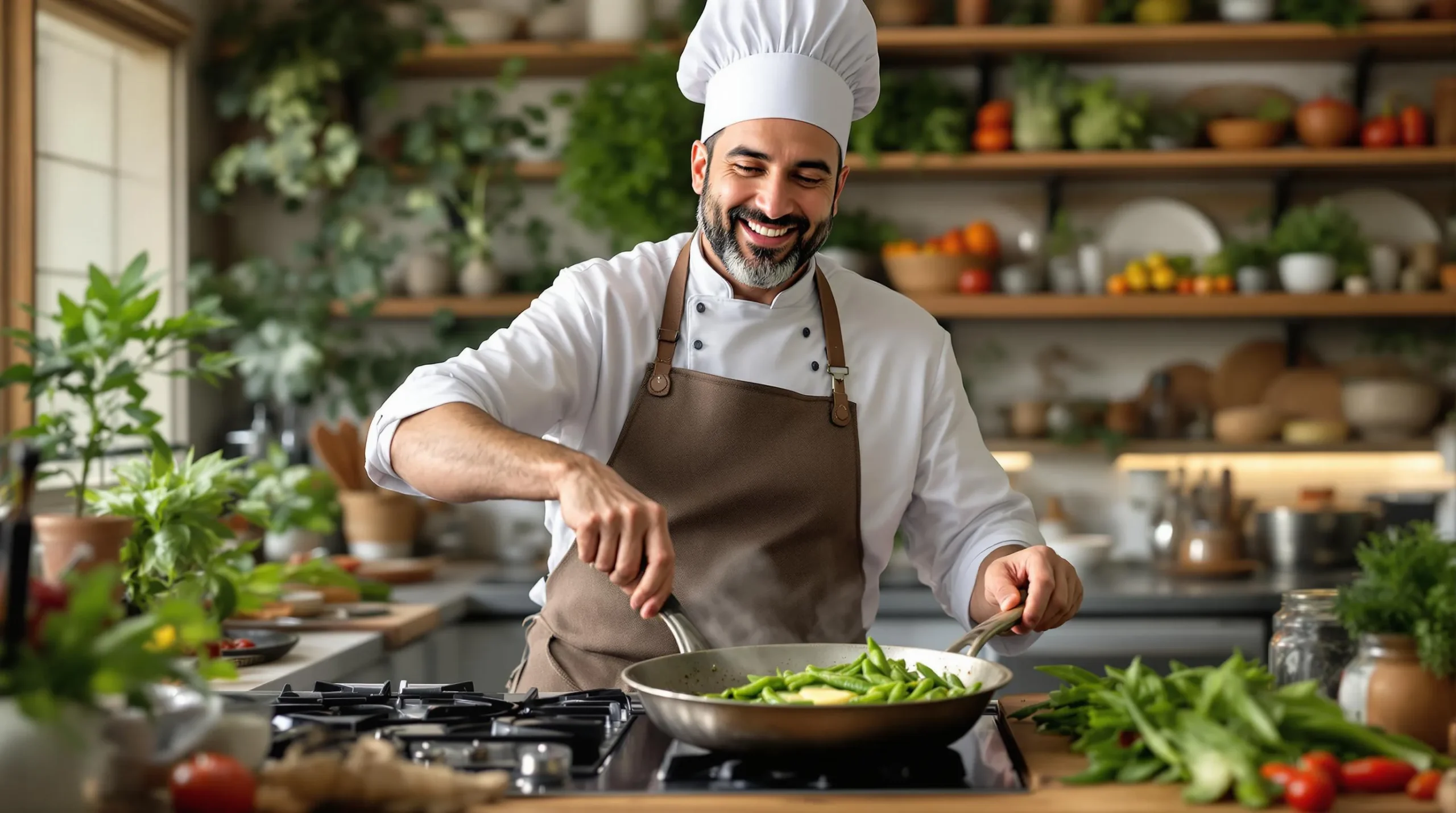
What Makes French Vegetable Cooking Unique
French vegetable cooking stands apart from other culinary traditions through its distinctive approach to ingredients preparation and cooking techniques. The French culinary philosophy elevates vegetables from mere accompaniments to celebrated components of a meal deserving careful attention and precise handling.
At the heart of French vegetable cooking lies the concept of “respect for the ingredient.” French chefs select vegetables at their peak ripeness understanding that timing is crucial for optimal flavor. Seasonal cooking isn’t just trendy in France—it’s fundamental to their culinary identity.
Butter plays an indispensable role in French vegetable preparation transforming ordinary produce into extraordinary dishes. Unlike other cuisines that might steam or boil vegetables French methods often begin with a generous amount of butter which creates rich foundational flavors.
Herbs and aromatics feature prominently in French vegetable dishes. Fresh thyme rosemary and bay leaves infuse vegetables with complex aromas while the classic combination of carrots onions and celery (mirepoix) forms the flavor base for countless preparations.
Patience characterizes authentic French vegetable cooking. Many classic dishes require slow cooking allowing flavors to develop fully. This unhurried approach results in vegetables with perfect texture and concentrated taste.
French vegetable recipes often incorporate wine or stock for deglazing pans which captures every bit of flavor from the cooking process. These liquids reduce to create natural sauces that enhance rather than mask the vegetable’s inherent qualities.
The French mastery of vegetable cooking also embraces contrasting textures. A perfectly executed gratin dauphinois demonstrates this principle with its crisp golden surface giving way to tender creamy layers beneath.
Essential French Cooking Techniques for Vegetables
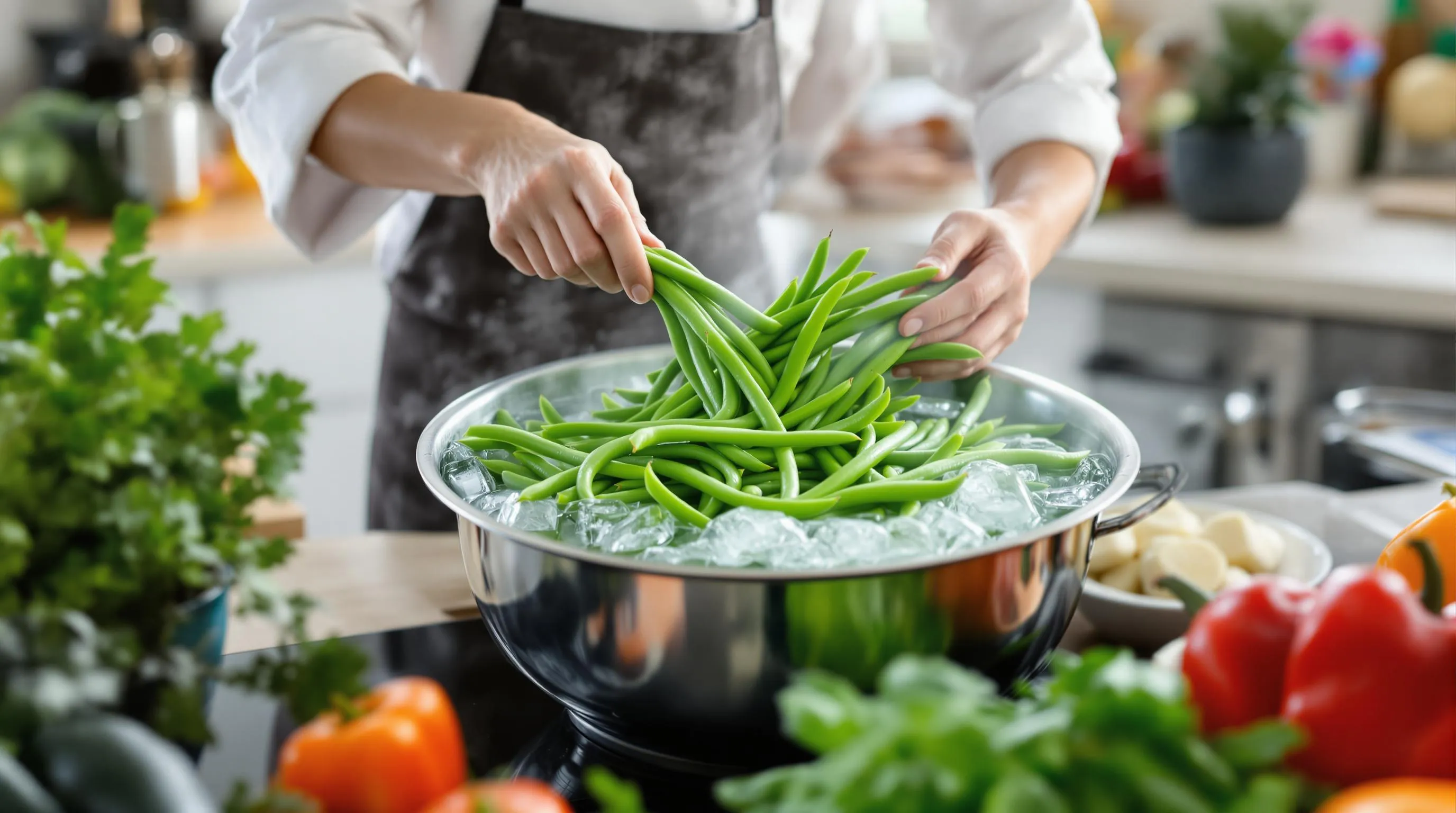
French cooking techniques for vegetables focus on preserving and improving natural flavors while maintaining perfect texture. These methods transform simple produce into extraordinary dishes through careful attention to detail and time-honored approaches.
Blanching (Blanchir)
Blanching is a fundamental French technique that involves briefly boiling vegetables then immediately plunging them into ice water to halt the cooking process. This method preserves the vibrant color, crisp texture, and nutritional value of vegetables while removing raw flavors. You’ll find this technique particularly useful for delicate vegetables like green beans, asparagus, and young spinach.
To blanch properly, bring a large pot of water to a rolling boil and add enough salt to make it taste like seawater. Prepare an ice bath in a separate bowl before adding your vegetables to the boiling water. Cook them just until their color brightens and they become slightly tender, then transfer them quickly to the ice bath. Young spinach blanched this way becomes the foundation for a classic French side dish when gently stewed with butter, flour, seasonings, and a touch of cream.
Braising (Braiser)
Braising vegetables involves cooking them slowly at low heat in a covered pot with a small amount of flavorful liquid. This patient technique develops deep, complex flavors while transforming firmer vegetables into tender delicacies. You’ll need a heavy-bottomed pot with a tight-fitting lid to create the ideal environment for this method.
The iconic French dish ratatouille showcases braising at its finest, combining zucchini, eggplant, bell peppers, tomatoes, and onions. These vegetables slowly cook in olive oil with aromatic herbs like thyme and basil, allowing their flavors to meld together beautifully. Begin by sautéing aromatics like onions and garlic, then add your vegetables and a small amount of liquid such as wine, stock, or water. Cover the pot and let everything simmer gently until the vegetables reach the perfect tenderness while absorbing all the surrounding flavors.
Sautéing (Sauter)
Sautéing, which literally means “to jump” in French, refers to quickly cooking vegetables in a small amount of fat over medium-high heat. This technique preserves the natural texture of vegetables while developing rich flavor through caramelization. You’ll want to use a wide, shallow pan that allows vegetables to cook evenly without crowding.
For perfect sautéed vegetables, heat your pan before adding butter or oil, then add vegetables cut to uniform sizes to ensure even cooking. Keep the vegetables moving in the pan—this prevents burning and promotes even browning. French chefs often finish sautéed vegetables with herbs, a splash of acid like lemon juice, or a small amount of butter swirled in at the end to create a light sauce. This technique works beautifully for mushrooms, zucchini, bell peppers, and countless other vegetables that benefit from quick cooking and caramelization.
When sautéing, pay attention to the order you add vegetables based on their cooking times. Denser vegetables like carrots may need to start first, while more delicate items like fresh herbs should be added at the very end. The simplicity of this method belies its importance in French cuisine, where properly sautéed vegetables form the foundation of countless classic dishes.
Classic French Vegetable Recipes
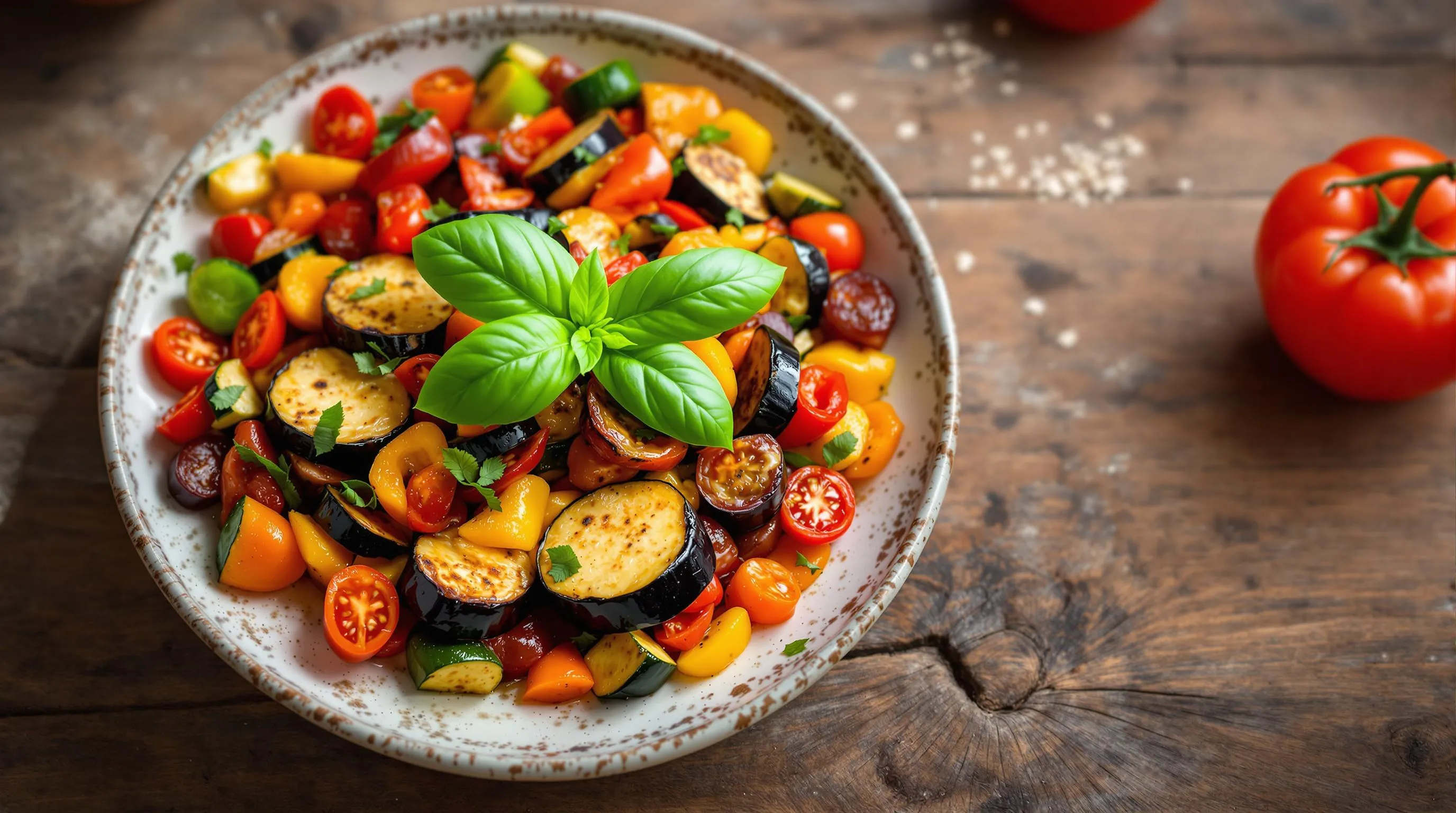
French cuisine has perfected the art of transforming humble vegetables into extraordinary dishes through time-honored techniques and thoughtful preparation. These three classic recipes showcase the essence of French vegetable cooking at its finest.
Ratatouille
This iconic Provençal stew originated in Nice and beautifully captures the vibrant flavors of southern French cooking. Ratatouille celebrates summer’s bounty with a harmonious blend of Mediterranean vegetables slowly cooked to perfection.
Ingredients:
- 1 large eggplant, cut into 1-inch cubes
- 2 medium zucchini, sliced into rounds
- 2 bell peppers (red and yellow), seeded and chopped
- 1 large onion, diced
- 4 ripe tomatoes, peeled and chopped
- 3 cloves garlic, minced
- 1/4 cup olive oil
- 2 tablespoons fresh thyme
- 1 bay leaf
- Salt and freshly ground pepper to taste
Preparation:
- Heat olive oil in a large, heavy-bottomed pot over medium heat.
- Add onions and cook until translucent, about 5 minutes.
- Stir in garlic and cook for another minute until fragrant.
- Add eggplant and bell peppers, cooking until they begin to soften.
- Incorporate zucchini, tomatoes, thyme, and bay leaf.
- Reduce heat to low and simmer uncovered for 45-60 minutes, stirring occasionally.
- Season with salt and pepper to taste.
- Allow the flavors to meld together – ratatouille often tastes even better the next day.
The secret to authentic ratatouille lies in cooking each vegetable to its optimal tenderness while maintaining distinct flavors throughout the dish.
Gratin Dauphinois
This luxurious potato dish from the Dauphiné region transforms simple ingredients into a creamy masterpiece. Gratin Dauphinois demonstrates how French cooking elevates humble root vegetables through patient technique and quality ingredients.
Ingredients:
- 2 pounds waxy potatoes, peeled and sliced 1/8-inch thick
- 2 cups whole milk
- 1 cup heavy cream
- 2 cloves garlic, one minced and one for rubbing
- 2 tablespoons butter
- 1/4 teaspoon freshly grated nutmeg
- Salt and white pepper to taste
Preparation:
- Preheat your oven to 350°F (175°C).
- Rub the inside of a baking dish with a cut garlic clove, then butter generously.
- Combine milk, cream, minced garlic, nutmeg, salt, and pepper in a large saucepan.
- Add potato slices to the liquid mixture and bring to a gentle simmer.
- Cook for about 10 minutes until potatoes are partially tender but not fully cooked.
- Carefully transfer the potatoes to the prepared baking dish, arranging them in even layers.
- Pour enough of the cream mixture over the potatoes to just reach the top layer.
- Dot with remaining butter and bake for 45-60 minutes until golden brown on top.
- Allow to rest for 10 minutes before serving.
The dish should emerge with a beautifully browned top and a tender interior where the potatoes have absorbed the rich dairy flavors.
Haricots Verts Amandine
This elegant side dish exemplifies the French approach to vegetable preparation – simple yet refined with emphasis on perfect technique. Haricots verts (thin French green beans) are elevated with the nutty richness of toasted almonds and the brightness of lemon.
Ingredients:
- 1 pound haricots verts, trimmed
- 1/3 cup sliced almonds
- 3 tablespoons unsalted butter
- 2 cloves garlic, minced
- 1 tablespoon fresh lemon juice
- Salt and freshly ground pepper to taste
- 2 tablespoons fresh parsley, chopped
Preparation:
- Bring a large pot of salted water to a boil.
- Blanch haricots verts for 2-3 minutes until bright green and tender-crisp.
- Transfer immediately to an ice bath to stop cooking.
- Drain thoroughly and pat dry with paper towels.
- Toast almonds in a dry skillet over medium heat until golden, about 3-4 minutes, then set aside.
- In the same skillet, melt butter over medium heat until it begins to foam.
- Add garlic and cook for 30 seconds until fragrant.
- Add the blanched green beans to the skillet, tossing to coat with butter.
- Cook for 2-3 minutes until heated through.
- Finish with lemon juice, toasted almonds, and fresh parsley.
- Season with salt and pepper before serving immediately.
The contrast between the crisp-tender beans, crunchy almonds, and rich butter sauce creates a perfect harmony of textures and flavors that showcases why French vegetable preparations are held in such high regard.
Essential Ingredients in French Vegetable Dishes
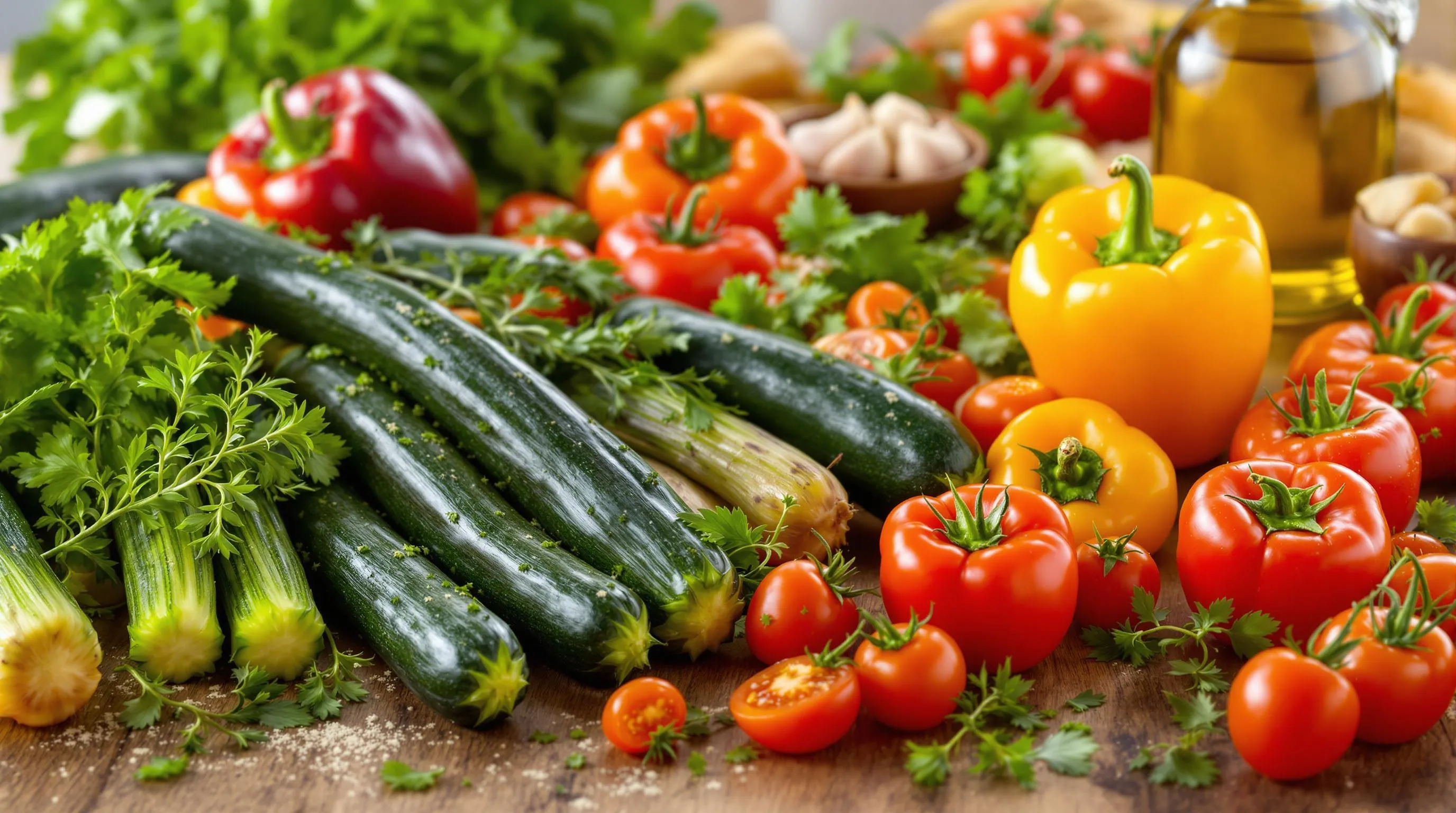
The art of French vegetable cooking relies on a carefully curated selection of ingredients that enhance rather than mask the natural flavors of seasonal produce. These foundational elements transform simple vegetables into dishes of remarkable depth and character.
Herbs and Aromatics
Fresh and dried herbs form the aromatic backbone of French vegetable dishes, infusing them with layers of flavor that evolve throughout the cooking process. Parsley, thyme, rosemary, tarragon, and basil appear frequently in both rustic country fare and refined restaurant preparations. Herbes de Provence—the iconic blend containing thyme, rosemary, oregano, and sometimes lavender—brings the essence of southern French hillsides to vegetable dishes like ratatouille and tian. Garlic and onions serve as essential building blocks, typically forming the first layer of flavor in many preparations and providing a sweet, savory foundation. These aromatics aren’t merely garnishes but integral components that harmonize with vegetables to create distinctive French flavor profiles.
Butter and Olive Oil
Regional traditions dictate the choice between butter and olive oil in French vegetable cookery, with each fat imparting unique characteristics to the finished dish. Northern French cuisine prizes butter for its incomparable richness and ability to create velvety textures in vegetable purées, sautés, and gratins. Southern regions, particularly Provence, favor olive oil’s fruity notes and lighter body when preparing Mediterranean-inspired dishes. Many classic recipes combine both fats to achieve optimal flavor and texture—butter for richness and olive oil for its higher smoke point when sautéing at higher temperatures. This thoughtful selection of cooking fats demonstrates the French commitment to improving vegetables rather than simply preparing them.
Wine and Stock
Deglazing pans with wine captures the caramelized flavors that develop during cooking while adding brightness and complexity to vegetable preparations. White wine brings acidity and subtle fruit notes to lighter dishes, while red wine contributes depth to heartier vegetable stews. Stocks—whether vegetable, chicken, or beef—provide a flavorful cooking medium that helps vegetables absorb savory notes during braising or stewing. These liquids create natural sauces that coat the vegetables without overwhelming their inherent flavors. The strategic use of wine and stock exemplifies how French cooking balances enhancement and respect—amplifying vegetable flavors while maintaining their essential character.
Equipment Needed for French Vegetable Cooking
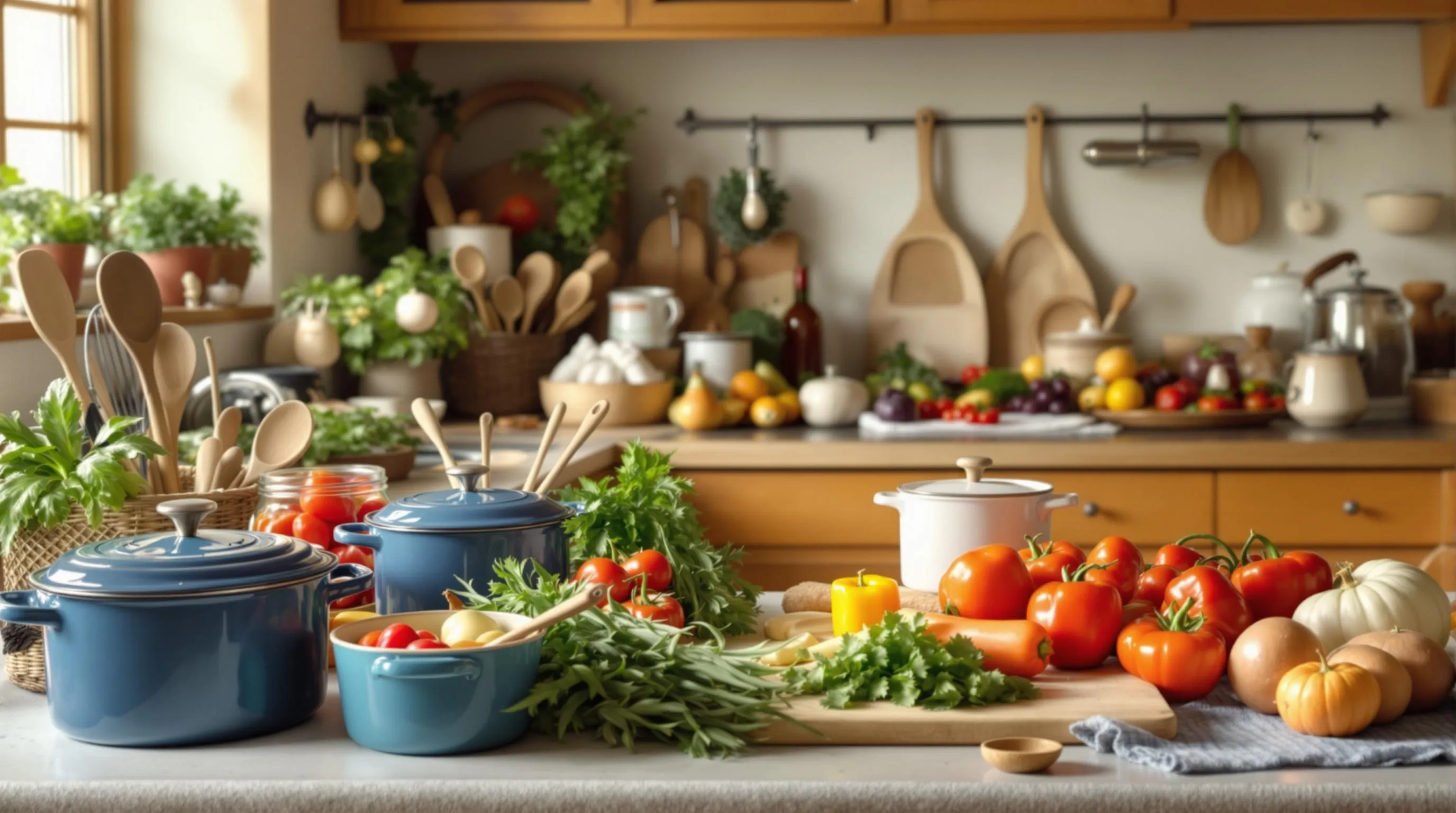
The artistry of French vegetable cooking relies not only on technique and ingredients but also on having the right tools at your disposal. Quality equipment enables you to execute classic French methods with precision while bringing out the best flavors in your vegetables.
Essential Kitchen Tools
Traditional French kitchens prioritize versatile tools that stand the test of time. Wooden utensils serve as daily essentials for stirring and sautéing vegetables without damaging your cookware surfaces. These gentle implements allow you to toss delicate vegetables with care while maintaining the integrity of your pans.
A proper steamer represents a fundamental piece of equipment for preserving nutrients and achieving that perfect tender-crisp texture in vegetables like asparagus and haricots verts. Steaming maintains vibrant colors and delicate flavors that might otherwise be lost in more aggressive cooking methods.
Various enamel saucepans and sieves perform crucial functions in vegetable preparation. The enamel provides excellent heat distribution while sieves allow for straining vegetable purées and sauces to achieve that silky texture prized in French cuisine.
A sturdy colander proves indispensable for rinsing and draining vegetables before cooking begins. This simple tool ensures your produce is properly cleaned and excess moisture removed before proceeding with your recipe.
Specialty Cookware
French vegetable cooking often requires exact vessels designed for particular techniques. All-purpose pots in various sizes accommodate everything from vegetable stews to broths and stovetop preparations. These workhorses of the French kitchen should be heavy-bottomed for even heat distribution.
Porcelain gratin dishes and earthenware roasting pans bring out exceptional flavors in baked vegetable preparations. The even heat distribution and retention qualities of these vessels make them perfect for classics like potato gratin dauphinois or a traditional Provençal ratatouille.
A French crêpe pan might seem specialized but offers versatility for cooking delicate vegetable-filled galettes or achieving perfect caramelization on thinly sliced vegetables. The shallow sides allow for easy flipping and movement of ingredients.
Tools for Technique
Executing classic French vegetable techniques requires exact equipment. For creating a proper mirepoix—the aromatic base of diced carrots, onions, and celery that begins countless French dishes—sharp knives and cutting boards are essential.
Tools that help the chiffonade technique allow you to create those signature fine ribbons of herbs and leafy greens that distinguish French cuisine. A sharp knife and steady hand transform ordinary ingredients into elegant garnishes.
Equipment for making vegetable coulis, such as a high-quality blender or food processor, enables you to create smooth purées that serve as sophisticated sauces for both vegetable and meat dishes.
The combination of these traditional kitchen tools allows you to apply authentic French techniques to your vegetable cooking, elevating simple produce into refined dishes that celebrate seasonal flavors with both rustic charm and elegant sophistication.
How to Select the Best Vegetables for French Cooking
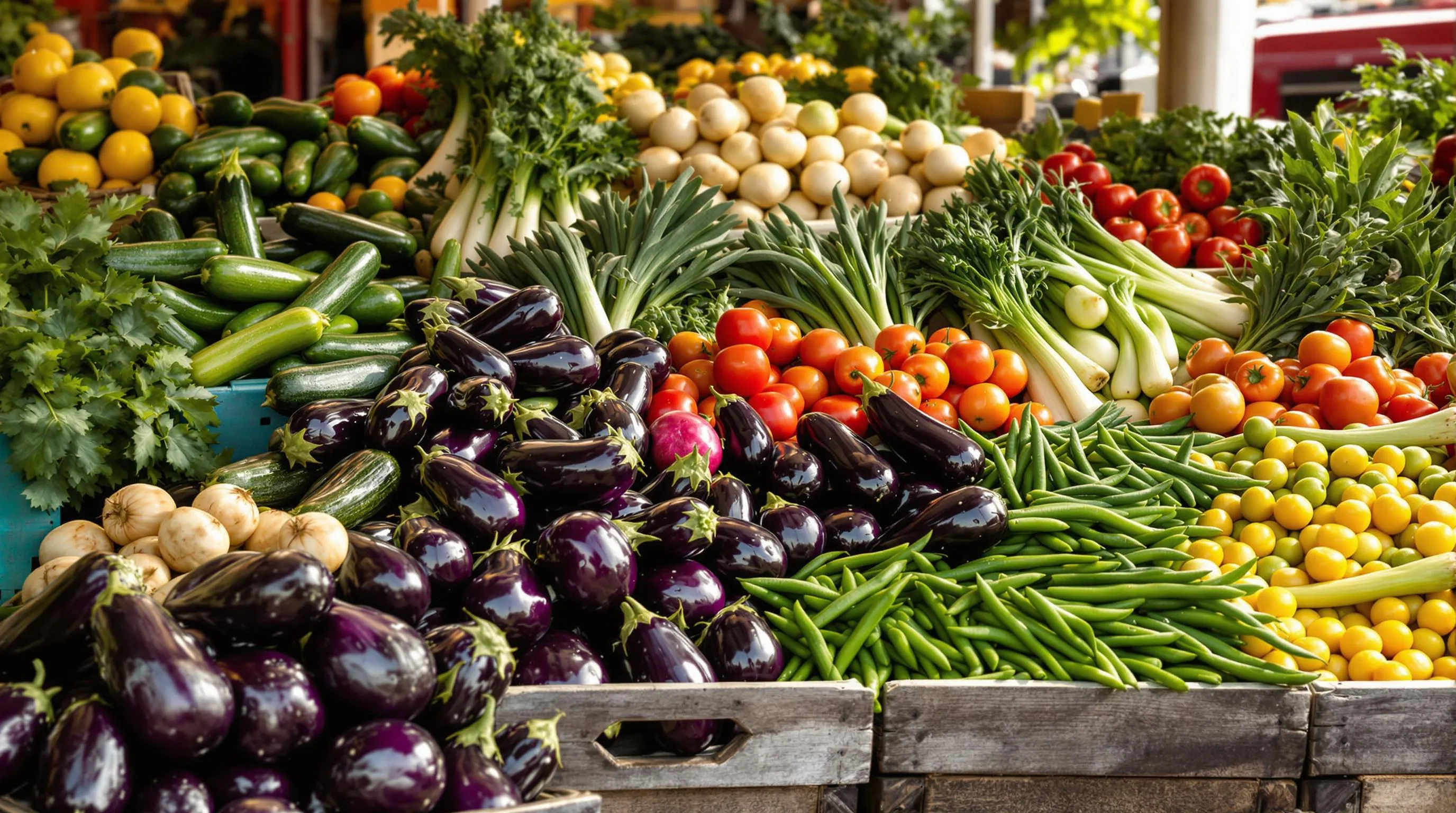
French cuisine elevates simple vegetables into extraordinary dishes through careful selection and preparation. Choosing the right produce is your first step toward authentic French cooking success. The French approach to vegetables centers around quality ingredients that showcase natural flavors.
Prioritize Seasonality
Your vegetable selection should always reflect what’s currently thriving in nature. French chefs build their menus around seasonal availability rather than forcing ingredients out of season. Summer brings perfect zucchini eggplant bell peppers tomatoes and onions ideal for classic Provençal ratatouille. Spring offers tender asparagus and young peas while autumn delivers hearty root vegetables for slow-cooked stews. Seasonal vegetables provide superior flavor nutritional value and typically cost less than out-of-season alternatives.
Look for Freshness Indicators
You’ll recognize quality vegetables by their vibrant colors firm textures and absence of blemishes. Fresh herbs like thyme basil and bay leaves should appear lively with strong aromatic qualities. When selecting leafy greens avoid wilted or yellowing leaves. Your tomatoes should feel heavy for their size and carrots should maintain their crispness. Fresh vegetables contribute significantly to the final flavor profile of dishes like Pistou Soup where each ingredient’s character remains distinct yet harmonious.
Consider Regional Traditions
Your French vegetable dishes gain authenticity when you select varieties traditional to exact regions. Haricots verts (French green beans) differ from standard varieties with their thinner more tender profile. Poireau (leek) features prominently in northern French cooking while aubergine (eggplant) and courgette (zucchini) dominate Mediterranean recipes. Regional vegetable selections reflect centuries of local agricultural traditions and cooking methods designed to highlight each area’s natural bounty.
Choose Vegetables That Complement Classic Cooking Methods
Your vegetable choices should work well with traditional French cooking fats and liquids. Sturdy root vegetables like carrots and turnips hold up beautifully when glazed with butter. Leafy greens such as spinach release their flavors gradually when stewed slowly in butter and finished with cream. Selecting vegetables that respond well to classic French techniques ensures your dishes develop the expected depth and complexity.
Ensure Uniform Sizing
Your preparation technique matters just as much as the quality of vegetables. Cut vegetables into consistent sizes to ensure even cooking especially in mixed dishes like ratatouille. Uniform pieces allow all components to reach perfect doneness simultaneously creating harmony in both texture and flavor. This attention to detail distinguishes professional French vegetable preparation from casual cooking.
| Vegetable | Peak Season | Classic French Use | Selection Tip |
|---|---|---|---|
| Leeks | Fall-Spring | Potage Parmentier | Firm with bright green tops |
| Haricots Verts | Summer | Haricots Verts Amandine | Thin slender pods that snap easily |
| Eggplant | Summer | Ratatouille | Glossy skin firm to touch |
| Zucchini | Summer | Tian Provençal | Small to medium size for best flavor |
| Carrots | Year-round | Carottes Vichy | Bright color firm texture |
The best vegetables for French cooking come from local markets and farms where you can personally assess quality and freshness. French home cooks traditionally shop several times weekly prioritizing just-harvested produce over convenience. This commitment to ingredient quality forms the foundation of authentic French vegetable cuisine where simple preparations allow natural flavors to shine.
Seasonal French Vegetable Dishes
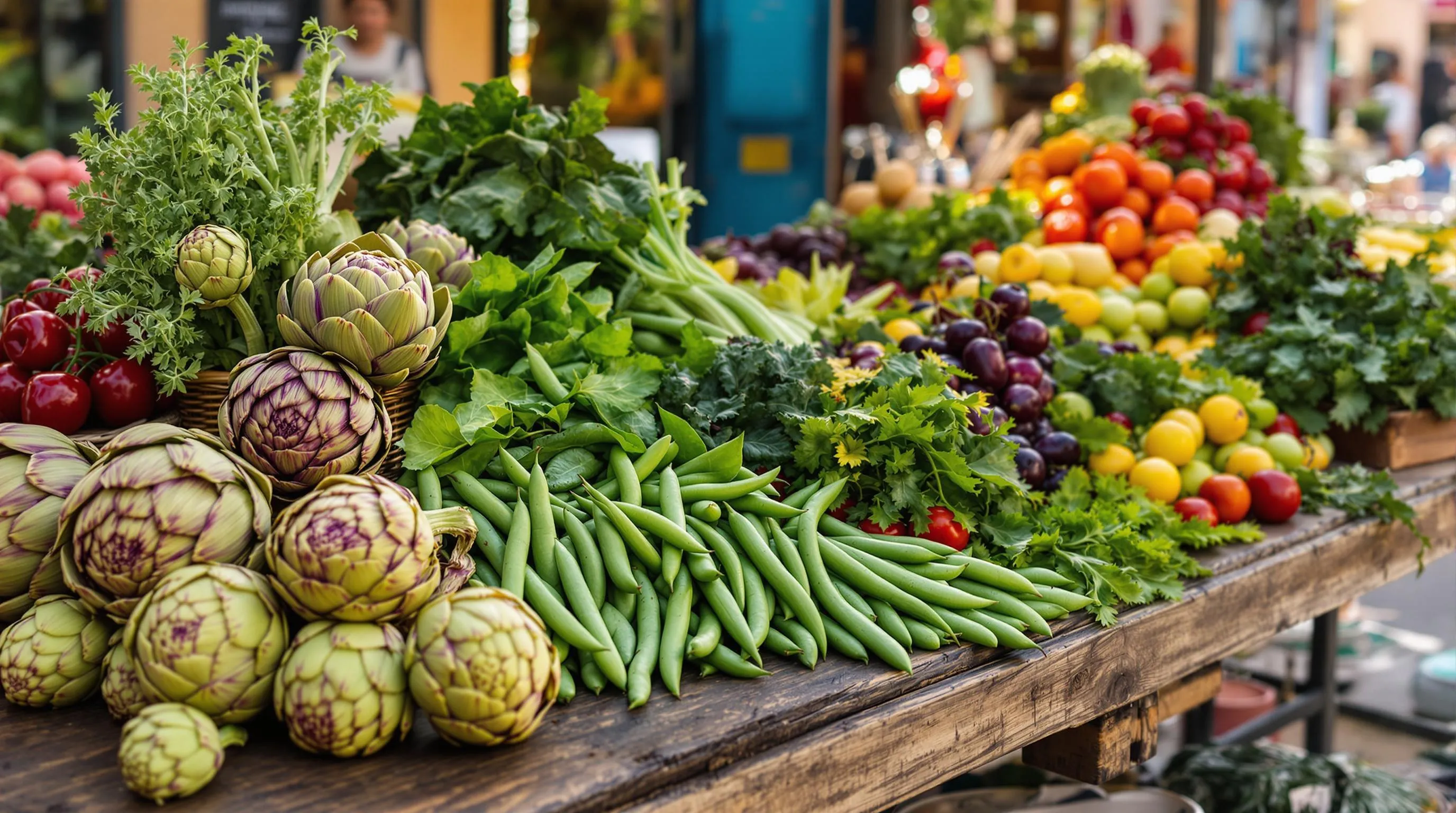
French cuisine celebrates the rhythm of the seasons with exquisite vegetable dishes that showcase produce at its peak. These seasonal preparations reflect France’s deep culinary tradition of honoring ingredients when they taste their best.
Spring Vegetables
Spring brings a revival to French markets with tender young vegetables that require minimal cooking to shine. Early spring vegetables like broccoli, cabbage, cauliflower, leeks, and collard greens dominate kitchen gardens and restaurant menus throughout France. These versatile ingredients form the foundation of many traditional dishes that celebrate the season’s first harvest.
As late spring arrives, fresh beans known as févettes make their anticipated appearance in April. French chefs typically serve these delicate legumes simply with butter and light seasoning to highlight their ephemeral sweetness. The simplicity of preparation allows their natural flavor to take center stage.
May brings magnificent artichokes to market stalls, with prized varieties including the white Camus breton and the distinctive purple Violet de Provence. These artichokes continue their season well into summer, offering versatility in many preparations from simple steaming with herb-infused butter to more complex stuffed presentations.
Summer Harvest
Summer in France delivers an abundance of sun-ripened vegetables that inspire colorful, vibrant dishes. Ratatouille stands as perhaps the most iconic summer vegetable creation in French cuisine. This Provençal vegetable stew marries zucchini, eggplant, bell peppers, tomatoes, and onions into a harmonious dish that captures the essence of Mediterranean summer. The vegetables slowly cook in olive oil until meltingly tender, perfumed with aromatic herbs like thyme and basil.
Fresh summer salads feature prominently during the warmer months, with mesclun taking a starring role on French tables. This traditional mix of young salad greens often includes peppery arugula and mustard greens for distinctive flavor. French chefs frequently enhance mesclun with crunchy radishes and sweet baby carrots to create textural contrast and visual appeal, dressed simply with the finest olive oil and wine vinegar.
Fall and Winter Roots
As temperatures cool, French cooking turns to heartier vegetables that provide comfort and sustenance. Leeks become available from September onward, lending their subtle onion flavor to warming soups, braised dishes, and the classic leek tart. Their versatility makes them a cornerstone ingredient in French kitchens throughout the colder months.
Early autumn markets fill with an array of root vegetables including carrots and turnips. These sturdy vegetables transform into satisfying stews or appear as elegant side dishes, often glazed with butter and a touch of sugar to enhance their natural sweetness. The slow cooking methods typical of French cuisine allow these humble ingredients to develop remarkable depth of flavor.
Winter brings the delicate green known as mâche (lamb’s lettuce) to its peak condition. This cold-season specialty actually improves with frost exposure, which concentrates its subtle, nutty flavor. Mâche provides a welcome fresh element to winter meals when other greens are scarce, typically dressed with walnut oil or incorporated into composed salads with beets and roasted vegetables.
Tips for Perfectly Cooked French Vegetables
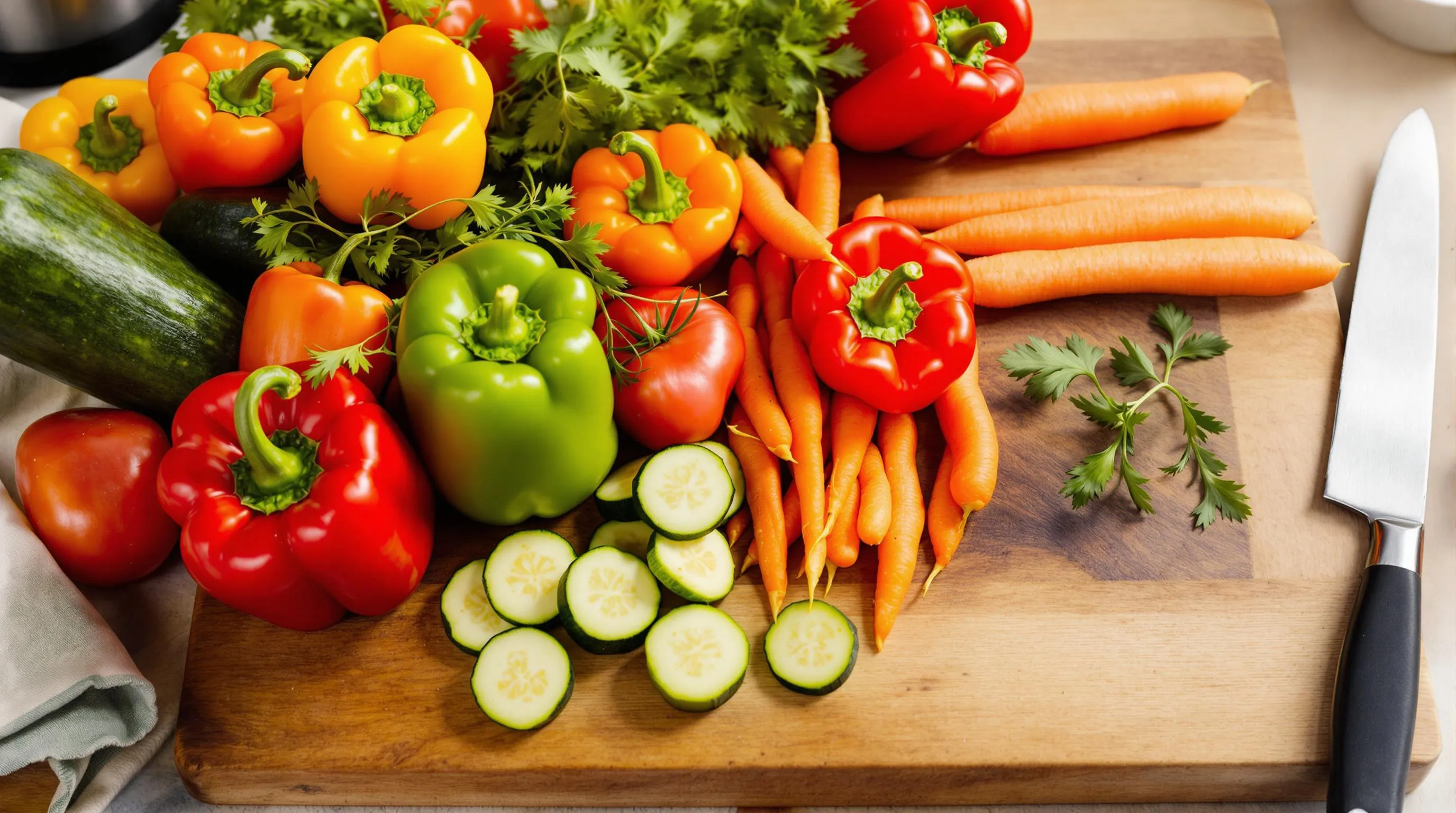
French cuisine elevates vegetables from simple side dishes to star attractions through meticulous attention to technique and quality. Apply these professional tips to achieve restaurant-worthy results in your own kitchen.
Start with seasonal produce. The foundation of exceptional French vegetable dishes begins at the market with selecting the freshest in-season vegetables. Peak-season produce delivers optimal flavor texture and nutritional value. Farmers markets offer the best opportunity to find truly fresh vegetables with the vibrant colors and firm textures that French cooking demands.
Master the mise en place. Prepare all ingredients before you begin cooking to ensure efficiency and consistency. This classic French organizational approach prevents overcooking while allowing you to focus entirely on technique once heat enters the equation.
Perfect your knife skills. Uniform cutting ensures even cooking and elegant presentation. Traditional French cuts like julienne (thin strips) brunoise (fine dice) macedoine (small cubes) and jardinière (small batons) each serve exact culinary purposes. Consistent sizing prevents some pieces from burning while others remain undercooked.
Blanch strategically. For sturdy greens like spinach a quick dip in boiling water followed by an ice bath preserves vibrant color and creates the perfect foundation for finishing with butter or cream. This technique prevents the dull appearance that direct sautéing can sometimes produce.
Cook with fat judiciously. Butter and olive oil are essential but should enhance rather than mask the vegetable’s natural flavor. A knob of high-quality butter can transform simple vegetables into luxurious sides without overwhelming their inherent qualities.
Layer flavors methodically. Build complexity by starting with aromatics like shallots and garlic then incorporating herbs and carefully reducing cooking liquids. This layered approach creates depth while still allowing the vegetable to remain the star.
Mind your cooking times. Vegetables should retain some bite rather than becoming mushy. French cooking embraces the “tender-crisp” texture that preserves natural flavor and structure. Different vegetables require different cooking times so resist the urge to cook everything together.
Finish with fresh elements. A sprinkle of just-chopped herbs or a squeeze of lemon juice brightens the dish and adds complexity. This final touch elevates the entire preparation and balances rich cooking methods with fresh vibrant notes.
Balance your seasoning. French vegetable cookery uses salt and pepper to enhance natural flavors rather than dominate them. Taste throughout the cooking process adding seasoning incrementally rather than all at once.
Respect regional traditions. Northern French cooking might rely more on butter while Provençal recipes favor olive oil. Understanding these distinctions helps you create more authentic dishes that honor the diverse culinary heritage of France.
How to Pair French Vegetable Dishes
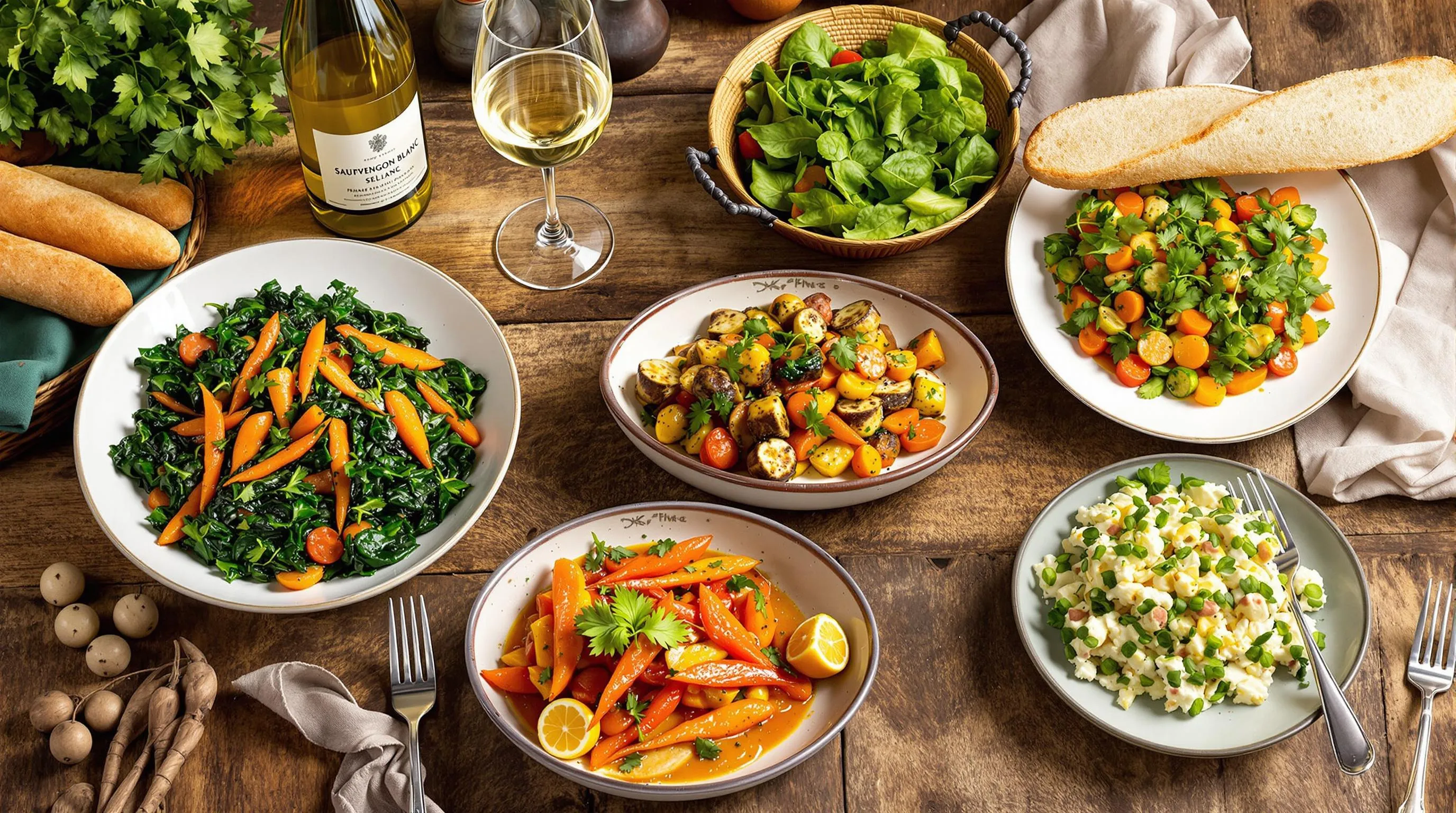
French vegetable dishes shine brightest when thoughtfully paired with complementary elements that enhance their natural flavors. Understanding the art of pairing transforms your vegetable preparations from simple sides to integral components of a harmonious French meal.
Focus on the Star Ingredient
Each French vegetable dish typically showcases one primary ingredient allowed to express its true character. Select pairings that complement rather than compete with your star vegetable’s flavor profile. Carrots glazed in butter need only a sprinkle of fresh parsley and perhaps a light protein to create a balanced plate. Root vegetables benefit from herbs with earthy notes while more delicate spring vegetables pair beautifully with lighter herbs like chervil or tarragon.
Herb Pairings That Elevate
Fresh herbs serve as perfect companions to French vegetable dishes offering aromatic complexity without overwhelming the primary ingredients:
- Thyme complements root vegetables and hearty preparations
- Basil brightens tomato-based dishes like ratatouille
- Tarragon adds distinctive anise notes to green vegetables
- Bay leaves infuse depth into slow-cooked vegetable medleys
These herbaceous elements enhance vegetables without masking their inherent qualities a principle central to French cooking philosophy.
Balancing Textures and Richness
French cuisine excels at creating textural contrast. Pair creamy vegetable dishes like spinach stewed with butter and flour with crisp elements that provide counterpoint. Buttered green beans (haricots verts) benefit from a sprinkle of toasted sliced almonds while creamed spinach finds perfect balance alongside a crusty piece of baguette.
The richness of butter or cream-based vegetable preparations often calls for acidic elements to cut through the richness. A splash of lemon juice or light vinaigrette can refresh the palate between bites of more indulgent vegetable dishes.
Wine and Beverage Pairings
Select beverages that complement rather than overpower your vegetable dishes:
- Light whites like Sauvignon Blanc enhance green vegetable preparations
- Herbaceous dishes pair wonderfully with Vermentino or Chenin Blanc
- Richer vegetable gratins call for a buttery Chardonnay
- Ratatouille and tomato-forward dishes benefit from rosé from Provence
Many French vegetable preparations incorporate wine directly into the cooking process creating natural affinity with similar wines at the table.
Creating a Balanced Meal
French meals traditionally feature vegetable dishes as vital components of a cohesive dining experience. Serve vegetable-forward sides alongside simple proteins that allow the produce to remain prominent. Light green salads dressed with a classic vinaigrette offer refreshing contrast to richer vegetable preparations.
The thoughtful inclusion of bread particularly a fresh baguette provides textural contrast and serves as the perfect vehicle for capturing sauces or juices from vegetable dishes. This traditional pairing exemplifies the French approach to meal composition where each element serves a purpose in creating a complete sensory experience.
Conclusion
French vegetable cooking transforms ordinary produce into extraordinary culinary experiences through time-honored techniques and a profound respect for ingredients. By embracing seasonal selection making butter your ally and mastering techniques like blanching and braising you’ll elevate your vegetable dishes to restaurant quality.
Remember that patience isn’t just a virtue in French cooking—it’s essential. Whether you’re layering potatoes for a perfect gratin or slowly simmering ratatouille the extra time yields incomparable flavor.
With the right tools quality ingredients and newfound techniques you’re now equipped to bring the elegance of French vegetable preparation to your kitchen. Your culinary journey has just begun—let the natural beauty of vegetables shine through your confident French-inspired cooking.
